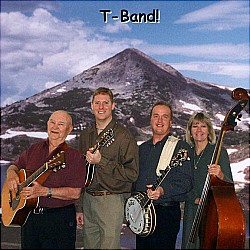Article Contributed by Gratefulweb
Published on June 9, 2004

The T-Band is based in northern Colorado and has been entertaining audiences for the past 13 years. From weddings to bars, parties to festivals, the T-Band always sets the mood for a good time.
Jim Dooney plays guitar and does most of the lead vocals. He is great at getting everyone involved in the fun by taking requests or choosing the perfect song for any situation. Amy Anderson plays the stand up bass and sings harmony. Amy is the musical backbone of the band. Her playing punch and solid timing keeps us all together in our all acoustic environment. Robert Griffith plays banjo and sings harmony. Rob drives the band with lightning fast fingers and great improvising skills. Rich Egan plays mandolin and does some vocals. Rich keeps your feet tapping and your fingers snapping with his rhythm chops and is great at playing tasteful solos.”